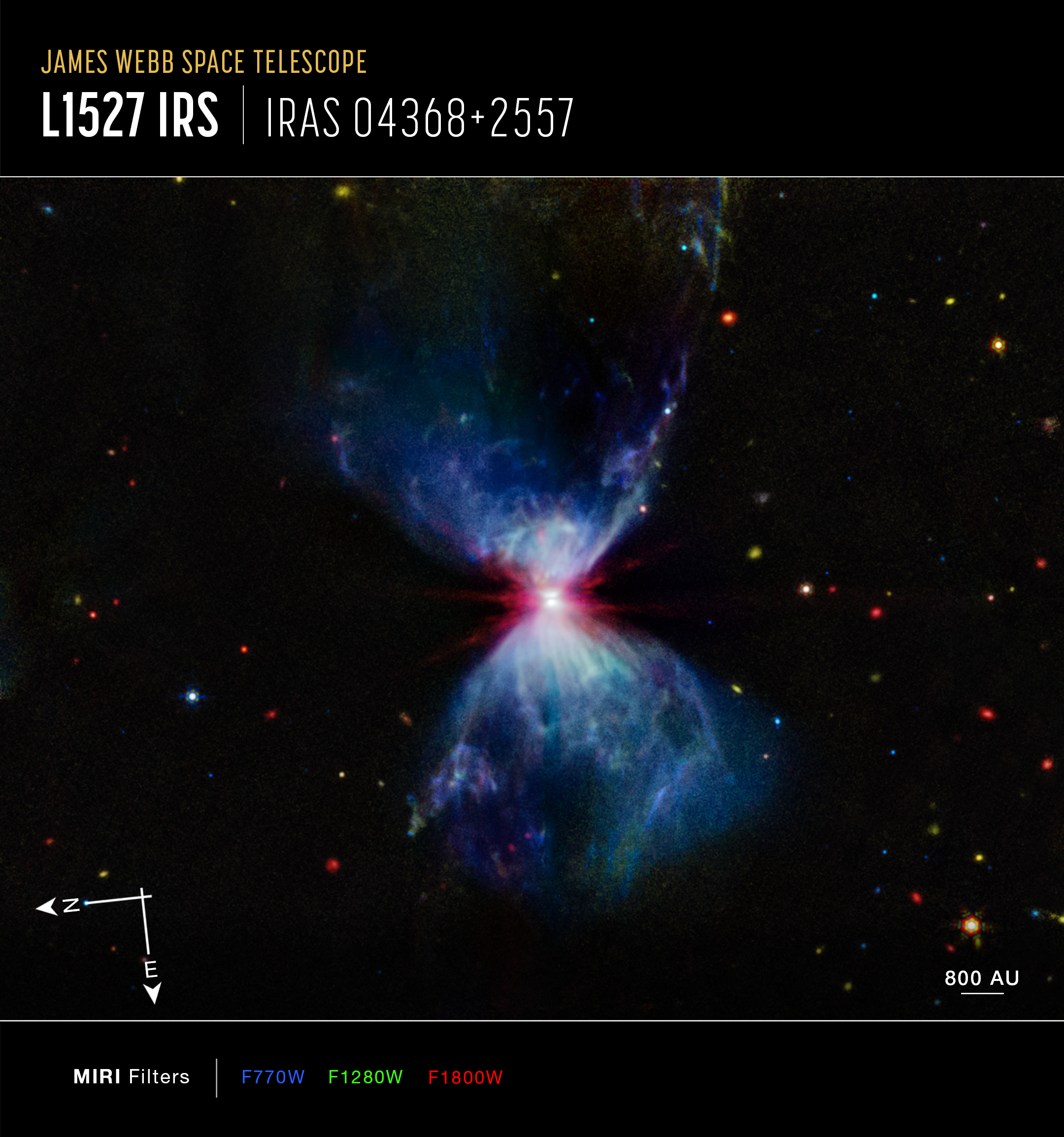1 min read
L1527 and Protostar (MIRI Image)

L1527, shown in this image from NASA’s James Webb Space Telescope’s MIRI (Mid-Infrared Instrument), is a molecular cloud that harbors a protostar. It resides about 460 light-years from Earth in the constellation Taurus. The more diffuse blue light and the filamentary structures in the image come from organic compounds known as polycyclic aromatic hydrocarbons (PAHs), while the red at the center of this image is an energized, thick layer of gases and dust that surrounds the protostar. The region in between, which shows up in white, is a mixture of PAHs, ionized gas, and other molecules.
This image includes filters representing 7.7 microns light as blue, 12.8 microns light as green, and 18 microns light as red.
About the Object
- R.A. PositionR.A. PositionRight ascension – analogous to longitude – is one component of an object's position.04:39:53.59
- Dec. PositionDec. PositionDeclination – analogous to latitude – is one component of an object's position.+26:03:05.50
- ConstellationConstellationOne of 88 recognized regions of the celestial sphere in which the object appears.Taurus
- DistanceDistanceThe physical distance from Earth to the astronomical object. Distances within our solar system are usually measured in Astronomical Units (AU). Distances between stars are usually measured in light-years. Interstellar distances can also be measured in parsecs.About 460 light-years
- DimensionsDimensionsThe physical size of the object or the apparent angle it subtends on the sky.Image is 2.37 arcmin across (about 0.32 light-years)
About the Data
- Data DescriptionData DescriptionProposal: A description of the observations, their scientific justification, and the links to the data available in the science archive.
Science Team: The astronomers who planned the observations and analyzed the data. "PI" refers to the Principal Investigator.This image was created from JWST data from proposal: 2739 (K. Pontoppidan). Image processing: Macarena Garcia Marin (STScI), Joseph DePasquale (STScI).
- InstrumentInstrumentThe science instrument used to produce the data.MIRI
- Exposure DatesExposure DatesThe date(s) that the telescope made its observations and the total exposure time.08 Sep 2022
- FiltersFiltersThe camera filters that were used in the science observations.F770W, F1280W, F1800W
- Object NameObject NameA name or catalog number that astronomers use to identify an astronomical object.L1527 IRS (IRAS 04368+2557)
- Object DescriptionObject DescriptionThe type of astronomical object.Young Stellar Object
- Release DateJuly 2, 2024
- Science ReleaseNASA’s Webb Captures Celestial Fireworks Around Forming Star
- CreditImage: NASA, ESA, CSA, STScI

These images are a composite of separate exposures acquired by the James Webb Space Telescope using the MIRI instrument. Several filters were used to sample different infrared wavelength ranges. The color results from assigning different hues (colors) to each monochromatic (grayscale) image associated with an individual filter. In this case, the assigned colors are: Blue: F770W, Green: F1280W, Red: F1800W

Related Images & Videos

L1527 and Protostar (MIRI Compass Image)
This image of the nebula L1527, captured by Webb’s Mid-Infrared Instrument (MIRI), shows compass arrows, a scale bar, and color key for reference. The north and east compass arrows show the orientation of the image on the sky. Note that the relationship between north and east on...
Share
Details
Laura Betz
NASA’s Goddard Space Flight Center
Greenbelt, Maryland
laura.e.betz@nasa.gov
NASA, ESA, CSA, STScI






























